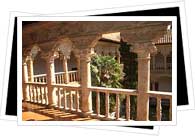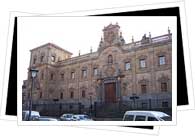Highlights:

East Salamanca is brimming with touristic must-sees, so be sure to pass through! Your first stop should definitely be the Convento de (Santa María de las Dueñas, an incredible convent which is still used today by Dominican nuns (hint: they make and sell incredible pastries!). While its church wasn't built until the early 16th century, the convent was constructed in the early 15th century and is yet another stellar example of Salamanca's Plateresque presence. Plus, it boasts the city's most beautiful cloister; built in an irregular pentagonal plan, the central courtyard and Renaissance cloister features two porticoed galleries, graceful arches and columns, and a beautifully kept garden. Check out the fascinating capitals topping the upper story columns featuring wildly carved human heads and skulls!
 Another stop on the religious pilgrimage through east Salamanca is the Convento de San Esteban. Between its Plateresque façade depicting the stoning death of the convent's patron, San Esteban (Saint Stephen), the wild mix of columns, statues, and floral motifs of the Churrigueresque alterpiece, and the part Gothic part Renaissance cloister that leads up to the choir stalls, the convent is a fascinating building with tons to be discovered.
Another stop on the religious pilgrimage through east Salamanca is the Convento de San Esteban. Between its Plateresque façade depicting the stoning death of the convent's patron, San Esteban (Saint Stephen), the wild mix of columns, statues, and floral motifs of the Churrigueresque alterpiece, and the part Gothic part Renaissance cloister that leads up to the choir stalls, the convent is a fascinating building with tons to be discovered.
Nearby you'll find the Colegio de Calatrava, a large and surprisingly sober building, considering it was designed by decoration-fanatic José de Churriguera. The building, which was originally designed as a school, is closed but pass by anyway- plus, it occasionally opens to host temporary exhibitions. Don't miss checking it out if you're given the opportunity!
One of the most fascinating buildings in Salmanca is the Convento de Santa Clara. The building, originally constructed in the 13th century, has an extremely plain exterior- but don't be fooled! Within the doors is an exquisite complex which, due to various additions and remodelings, boasts everything from Romanesque and Mudejar (Moorish-inspired) architecture to late Baroque.
Plus, like in the Salamanca University quarter, the convent has a few secrets of its own- some of which have only recently been discovered! For example, the interior of part of the convent had been white-washed during a cholera epidemic long, long ago. Beneath the paint, however, restorers discovered an important series of painted frescoes that nobody had seen for centuries. A second of the discoveries is the Baroque ceiling designed by- surprise, surprise- yet another Churriguera: Joaquín. It turns out that his ceiling is false! Rising above it allows you to see the original Gothic 14th century beams decorated with motifs of the kingdoms of Castilla and León. After a prize-winning restoration, it's definitely worth a look. Plus, up above you get the best view of the cathedral, so grab your camera and get a glimpse.
Completely devoid of the grandeur and visual splendor typical of Salamanca's Plateresque and Churrigueresque architecture is the tiny Iglesia de Santo Tomás Canturiense. Erected in 1175 in the Romanesque style, it's the first church in the world dedicated to Saint Thomas Becket and a wide range of people are interred within its grounds.